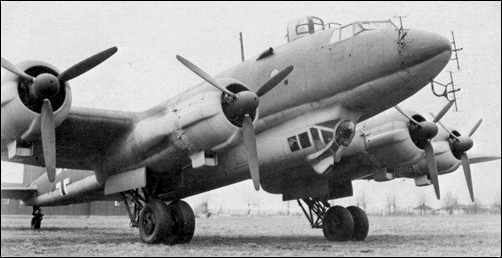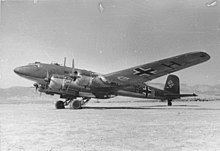Top speed 360 km/h Wingspan 33 m | Length 23 m First flight July 27, 1937 | |
 | ||
Focke wulf fw 200 condor grenzmark d acvh
The Focke-Wulf Fw 200 Condor, also known as Kurier to the Allies was a German all-metal four-engined monoplane originally developed by Focke-Wulf as a long-range airliner. A Japanese request for a long-range maritime patrol aircraft led to military versions that saw service with the Luftwaffe as long-range reconnaissance and anti-shipping/maritime patrol bomber aircraft. The Luftwaffe also made extensive use of the Fw 200 as a transport.
Contents
- Focke wulf fw 200 condor grenzmark d acvh
- R c oldtimer focke wulf fw 200 condor 3 airlinertreffen 2015 germany
- Design and development
- Operational history
- Hitlers personal transport
- Variants
- Civil operators
- Military operators
- Accidents and incidents
- Surviving aircraft
- Specifications Fw 200C 3U4
- References

It achieved success as a commerce raider before the advent of long-range RAF Coastal Command aircraft and CAM ships eliminated its threat.

R c oldtimer focke wulf fw 200 condor 3 airlinertreffen 2015 germany
Design and development

The Fw 200 resulted from a proposal by Kurt Tank of Focke-Wulf to Dr. Rudolf Stuessel of Deutsche Lufthansa to develop a landplane to carry passengers across the Atlantic Ocean to the USA. At that time this was unusual, as airlines used seaplanes on long over-water routes. To fly long distances economically, the Fw 200 was designed to cruise at an altitude of over 3,000 m (9,800 ft) - as high as possible without a pressure cabin. Existing airliners were designed to cruise at altitudes below 5,000 feet. The Fw 200 was briefly the world's most modern airliner, until other high-altitude airliners started operating: the Boeing 307 in 1940 and the Douglas DC-4 in 1942. The designation "Condor" was chosen because, like the condor bird, the Fw 200 had a very long wingspan, to facilitate high-altitude flight.

Deutsche Lufthansa issued a specification in June 1936 after discussions between Tank, Dr. Stüssel and Carl August von Gablenz. The plane was designed by Ludwig Mittelhuber with Wilhelm Bansemir as project director. The first prototype, the Fw 200 V1, made its first flight after just over one year of development on 27 July 1937 with Kurt Tank at the controls. It was an all-metal, four-engined monoplane powered by four American 875 hp Pratt & Whitney Hornet radial engines, and intended to carry 26 passengers in two cabins for up to 3,000 km (1,860 mi). Two further prototypes were powered by German 720 hp BMW 132G-1 radials.

The Japanese Navy requested a military version of the Fw 200 for search and patrol duties, so Tank designed the Fw 200 V10 with military equipment. This Fw 200 was held in Germany because war had broken out in Europe by that time. This aircraft became the basis for all later military models used by the Luftwaffe.
To adapt it for wartime service, hardpoints were added to the wings for bombs, the fuselage was strengthened and extended to create more space, and front, aft and dorsal gun positions were added, in addition to an extended-length version of the Bola ventral gondola typical of World War II German bomber aircraft; for the Fw 200's militarization this incorporated a bomb bay as well as heavily glazed forward and aft flexible defensive machine gun emplacements at either end. The extra weight introduced by its military fitments meant that a number of early Fw 200 aircraft broke up on landing, a problem that was never entirely solved. Later models were equipped with Lorenz FuG 200 Hohentwiel low UHF-band ASV radar in the nose. In 1943 a version entered service that could carry the Henschel Hs 293 guided missile, mandating fitment of the associated Funkgerät FuG 203 Kehl radio guidance gear on a Condor to steer them.
Operational history
The Fw 200 was operated by Deutsche Lufthansa, DDL Danish Airlines and Lufthansa's Brazilian subsidiary Syndicato Condor. Dai Nippon KK of Japan also ordered Fw 200 airliners. These could not be delivered to Japan once the war began, so they were delivered to Deutsche Lufthansa instead. On 14 April 1945 an Fw 200 flew Lufthansa's last scheduled service before the end of World War II, from Barcelona to Berlin. Other airlines continued to operate the Fw 200 after the end of World War II.
The first prototype, the Fw 200 V1, upgraded with extra fuel tanks and redesignated Fw 200 S-1, made several record flights. It was the first heavier-than-air craft to fly nonstop between Berlin and New York City (c.4000 miles), making the flight from Berlin-Staaken to Floyd Bennett Field on 10/11 August 1938 in 24 hours and 56 minutes. The return trip on 13 August 1938 took 19 hours and 47 minutes. These flights are commemorated with a plaque in Böttcherstraße, a street in Bremen. Beginning on 28 November 1938 it flew from Berlin to Tokyo via Basra, Karachi and Hanoi.
The German Foreign Minister, Joachim von Ribbentrop, used a specially outfitted Condor "Grenzmark", on his two flights to Moscow in 1939, during which he negotiated and signed the Treaty of Non-Aggression between Germany and the Soviet Union. Original film footage of his arrival shows his aircraft bearing the German civil registration of D-ACVH.
A Danish-owned Fw 200 aircraft named Dania was seized by the British on English soil after Denmark was invaded by German forces in 1940. It was subsequently operated by the British Overseas Airways Corporation (BOAC) and was then pressed into service with the Royal Air Force. It was damaged beyond repair in 1941.
The Luftwaffe initially used the aircraft to support the Kriegsmarine, making great loops out across the North Sea and, following the fall of France, the Atlantic Ocean. The aircraft was used for maritime patrols and reconnaissance, searching for Allied convoys and warships that could be reported for targeting by U-boats. The Fw 200 could also carry a 900-kilogram (2,000 lb) bomb load or naval mines to use against shipping, and it was claimed that from June 1940 to February 1941, they sank 331,122 tonnes (365,000 tons) of shipping despite a rather crude bombsight. The attacks were carried out at extremely low altitude in order to "bracket" the target ship with three bombs; this almost guaranteed a hit. Winston Churchill called the Fw 200 the "Scourge of the Atlantic" during the Battle of the Atlantic due to its contribution to the heavy Allied shipping losses.
From mid-1941, Condor crews were instructed to stop attacking shipping and avoid all combat in order to preserve numbers. In August, the first Fw 200 was shot down by a CAM ship-launched Hawker Hurricane, and the arrival of the U.S.-built Grumman Martlet, operating from the Royal Navy's new escort carriers, posed a serious threat. On 14 August 1942, an Fw 200C-3 was the first German aircraft to be destroyed by USAAF pilots, after it was attacked by a P-40C and a P-38F over Iceland.
The Fw 200 was also used as a transport aircraft, notably flying supplies into Stalingrad in 1942. After late-1943, the Fw 200 came to be used solely for transport. For reconnaissance, it was replaced by the Junkers Ju 290, and even some examples of the Heinkel He 177A serving with KG 40. As France was liberated, maritime reconnaissance by the Luftwaffe became impossible as the Atlantic coast bases were captured. Production ended in 1944 with a total of 276 aircraft produced.
Several damaged Fw 200s landed in Spain during the war. In the beginning, they were repaired and returned to their bases in France. After Operation Torch (the Allied invasion of Africa), the Spanish government interned four aircraft that arrived (although their crews were still allowed to return to Germany). Since the aircraft could not be used, they were sold by Germany to Spain. One of the three flyable aircraft was then operated by the Spanish Air Force and the others used for spares. Because of damage and lack of spares, and for political reasons, they were grounded and scrapped in around 1950.
Some Condors also crashed in Portugal. Their crews were allowed to return to Germany while the British authorities were allowed to inspect the aircraft and accompanying documentation. Some crew members died in these crashes and are buried in the civilian cemetery of Moura in Alentejo Province, Portugal. The aircraft that crashed in Spain and Portugal had been based in Bordeaux-Merignac, France since 1940. Before then, the operational base of the Fw 200 squadrons had been in Denmark.
Hitler's personal transport
At the suggestion of his personal pilot Hans Baur, Adolf Hitler specified a modified and unarmed prototype Condor, the Fw 200 V3, as his personal transport, as a replacement for his Junkers Ju 52. Originally configured as a 26-passenger Lufthansa transport (Works No. 3099), it was reconfigured as a plush two-cabin airliner. Hitler's seat in the cabin was equipped with a wooden table, seat-back armour plating, and an automatic parachute with downward throws. According to Baur, it was never armed. In line with Hitler's aircraft preferences, it carried the markings "D-2600" and named "Immelmann III" in honor of World War I flying ace Max Immelmann. As the war progressed it changed designation to "WL+2600" and finally "26+00"; it was destroyed at Berlin Tempelhof Airport in an Allied bombing raid on 18 July 1944.
Variants
There were three variants of the aircraft: the Fw 200A, B, and C. The Model A was a purely civilian variant used by Deutsche Lufthansa, DDL in Denmark, and Syndicato Condor in Brazil. The Fw 200B and Fw 200C models were used as long-range bombers, reconnaissance, troop and transport aircraft.
Civil operators
Military operators
Accidents and incidents
Surviving aircraft
Only one relatively complete Fw 200 exists today, an aircraft that ditched in February 1942 and sank to a depth of 60 meters (197 feet). This aircraft was raised from Trondheim Fjord in Norway on 26 May 1999. Although the airframe disintegrated whilst being lowered onto a recovery platform, the remains were transported to the German Museum of Technology in Berlin to be rebuilt. A request from the museum for a set of separate wings to be recovered from the Kvitanosi mountain near Voss in Norway to complete the rebuild was at first denied, because the local population wanted the wings to be left in situ as a war memorial. A compromise was reached in 2008 where parts not needed for the restoration would be left on the mountain. During autumn of 2009 parts were moved down by helicopter and made ready for transport to the Museum of Technology.
Specifications (Fw 200C-3/U4)
Data from Warplanes of the Luftwaffe
General characteristics
Performance
Armament
